Drawing a ballerina dancer can be fun and rewarding, especially when you have the right guidance, and at ten-dance.com, we make learning to draw simple and enjoyable, and this guide will take you through each step to create your graceful ballerina masterpiece. With easy-to-follow instructions, tips, and inspiration, you’ll discover the joy of capturing the elegance and beauty of ballet on paper. Dive in and let your creativity dance.
1. Why Learn How to Draw a Ballerina Dancer?
Learning How To Draw A Ballerina Dancer offers numerous benefits for artists of all levels. It’s not just about putting pencil to paper; it’s about understanding movement, form, and the beauty of the human body in motion.
- Capturing Elegance: Drawing ballerinas helps you appreciate and represent the grace and fluidity of dance.
- Improving Observational Skills: You’ll learn to see and translate complex poses into simple shapes.
- Enhancing Artistic Skills: This practice strengthens your understanding of anatomy, proportion, and composition.
- Boosting Creativity: Ballerina drawings provide a canvas for your imagination, allowing you to add unique flair and style.
- Relaxation and Enjoyment: The process of drawing can be a calming and fulfilling activity.
According to research from the National Endowment for the Arts in July 2023, engaging in artistic activities enhances cognitive functions and promotes emotional well-being.
2. Who is This Guide For?
This guide is crafted for a diverse audience, catering to various skill levels and interests.
- Beginner Artists (18-35): If you’re new to drawing, this guide provides a simple, step-by-step approach to get you started with confidence.
- Intermediate Artists (25-55): Looking to refine your skills? This guide offers techniques to improve your understanding of anatomy and movement.
- Dance Enthusiasts (18-55): Whether you’re a dancer or simply appreciate the art, this guide allows you to express your passion through drawing.
- Art Teachers and Educators: This resource offers a structured approach to teaching ballerina drawing to students.
- Anyone Seeking a Creative Outlet: If you’re looking for a relaxing and fulfilling hobby, drawing ballerinas can be a perfect choice.
Our content at ten-dance.com is designed to be accessible and engaging for everyone, regardless of their background or experience.
3. Understanding the Intent Behind “How to Draw a Ballerina Dancer”
When people search for “how to draw a ballerina dancer,” they typically have specific intentions in mind. Understanding these intentions allows us to provide the most relevant and helpful content. Here are five common search intents:
- Step-by-Step Tutorials: Users want easy-to-follow instructions for drawing a ballerina, breaking down the process into manageable steps.
- Inspiration and Ideas: Many seek inspiration for different ballerina poses, styles, and artistic interpretations.
- Technique Improvement: Some users are looking for tips and techniques to enhance their drawing skills, such as proportion, shading, and detail.
- Educational Resources: Teachers and parents often search for resources to teach children how to draw ballerinas in a fun and engaging way.
- Reference Material: Artists may need reference images and guides to accurately depict ballerina anatomy and attire.
At ten-dance.com, we aim to address all these intentions by providing comprehensive guides, inspiring examples, and valuable resources for artists of all levels.
4. Essential Materials for Drawing a Ballerina Dancer
Before you start drawing, it’s essential to gather the right materials. Having the right tools can make the process smoother and more enjoyable.
- Pencils:
- HB Pencil: For sketching and light outlines.
- 2B and 4B Pencils: For shading and adding depth.
- Paper:
- Sketchbook: For practicing and quick sketches.
- Drawing Paper: For finished pieces.
- Erasers:
- Kneaded Eraser: For lifting graphite and creating highlights.
- Pencil Eraser: For precise corrections.
- Sharpener:
- Manual Sharpener: To keep your pencils sharp.
- Blending Tools:
- Blending Stumps: For smooth shading.
- Cotton Swabs: For blending small areas.
- Optional Materials:
- Ruler: For straight lines and accurate measurements.
- Compass: For drawing circles and curves.
- Colored Pencils or Markers: For adding color and detail.
Having these materials on hand will set you up for a successful drawing experience.
5. Step-by-Step Guide to Drawing a Ballerina Dancer
This step-by-step guide will walk you through the process of drawing a ballerina dancer, from basic shapes to detailed finishing touches.
5.1. Step 1: Start with Basic Shapes
Begin by sketching basic shapes to outline the ballerina’s pose.
- Head: Draw a small oval for the head.
- Torso: Add a curved line for the spine and an oval for the torso.
- Limbs: Use simple lines to represent the arms and legs, indicating their position and angle.
This initial sketch helps establish the overall composition and proportions.
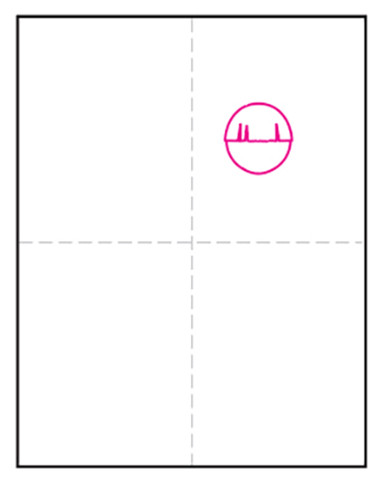 Basic shapes outline for drawing a ballerina dancer, starting with ovals and lines to represent the head, torso, and limbs
Basic shapes outline for drawing a ballerina dancer, starting with ovals and lines to represent the head, torso, and limbs
5.2. Step 2: Refine the Body Shape
Refine the basic shapes to create a more defined body shape.
- Head: Add details to the head, such as the hairline and ear placement.
- Torso: Shape the torso to reflect the curves of the ballerina’s body.
- Limbs: Thicken the lines for the arms and legs, outlining the muscles and joints.
Pay attention to the natural curves and contours of the body to create a realistic silhouette.
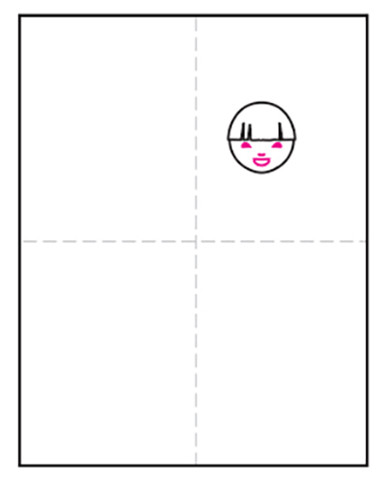 Refining the body shape of a ballerina dancer, adding curves to the torso and defining the lines for the arms and legs
Refining the body shape of a ballerina dancer, adding curves to the torso and defining the lines for the arms and legs
5.3. Step 3: Add Facial Features and Hair
Add facial features and hair to bring your ballerina to life.
- Eyes: Draw almond-shaped eyes with pupils and eyelids.
- Nose: Sketch a simple, elegant nose.
- Mouth: Add a subtle smile or a focused expression.
- Hair: Outline the hairstyle, such as a bun or ponytail, with flowing lines.
Focus on capturing the expression and personality of your ballerina.
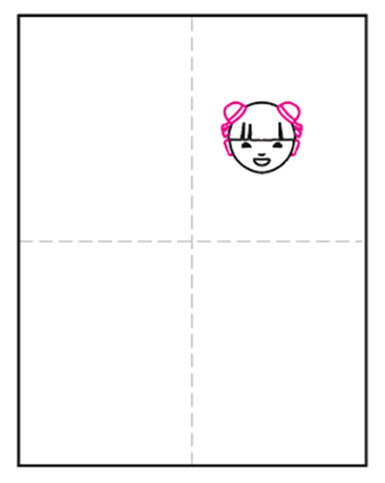 Adding facial features and hair to the ballerina dancer, sketching almond-shaped eyes, a simple nose, and outlining the hairstyle in flowing lines
Adding facial features and hair to the ballerina dancer, sketching almond-shaped eyes, a simple nose, and outlining the hairstyle in flowing lines
5.4. Step 4: Sketch the Costume
Sketch the ballerina’s costume, including the leotard and tutu.
- Leotard: Outline the leotard, following the contours of the body.
- Tutu: Add a tutu, using layers of curved lines to create a sense of volume and movement.
- Details: Include details such as ribbons, straps, and embellishments.
Pay attention to the fabric’s folds and how it drapes around the body.
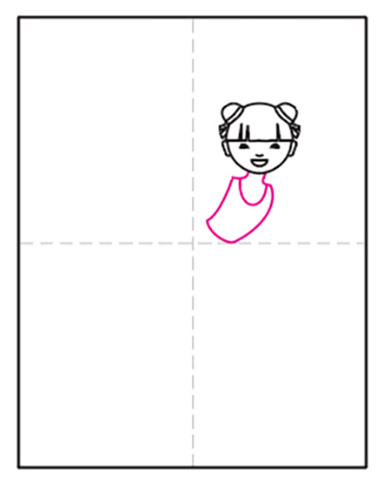 Sketching the costume of the ballerina dancer, including the leotard following the body contours and a layered tutu for volume and movement
Sketching the costume of the ballerina dancer, including the leotard following the body contours and a layered tutu for volume and movement
5.5. Step 5: Draw the Arms and Hands
Draw the arms and hands, paying attention to their gestures and poses.
- Arms: Outline the arms, indicating the muscles and curves.
- Hands: Sketch the hands in elegant poses, such as holding a ballet position.
- Fingers: Add details to the fingers, capturing their length and shape.
Focus on conveying the grace and fluidity of the arms and hands.
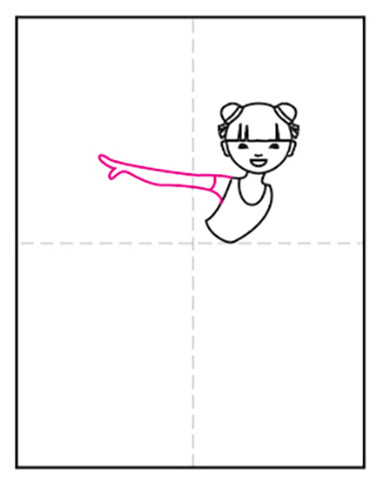 Drawing the arms and hands of the ballerina dancer, outlining the muscles and sketching the hands in elegant ballet poses
Drawing the arms and hands of the ballerina dancer, outlining the muscles and sketching the hands in elegant ballet poses
5.6. Step 6: Draw the Legs and Feet
Draw the legs and feet, emphasizing their strength and flexibility.
- Legs: Outline the legs, indicating the muscles and curves.
- Feet: Sketch the feet in ballet shoes, capturing their pointed and arched shape.
- Details: Add details such as ribbons and ankle straps.
Pay attention to the balance and posture of the legs and feet.
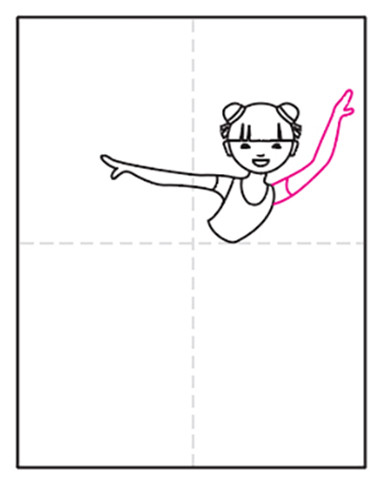 Drawing the legs and feet of the ballerina dancer, outlining the muscles and sketching the feet in ballet shoes with pointed and arched shapes
Drawing the legs and feet of the ballerina dancer, outlining the muscles and sketching the feet in ballet shoes with pointed and arched shapes
5.7. Step 7: Add Details and Shading
Add details and shading to create depth and dimension.
- Shading: Use light and dark tones to create shadows and highlights on the body and costume.
- Details: Add details such as wrinkles in the fabric, strands of hair, and facial expressions.
- Texture: Create texture by varying the pencil strokes and adding fine lines.
Enhance the realism and visual appeal of your drawing with careful shading and details.
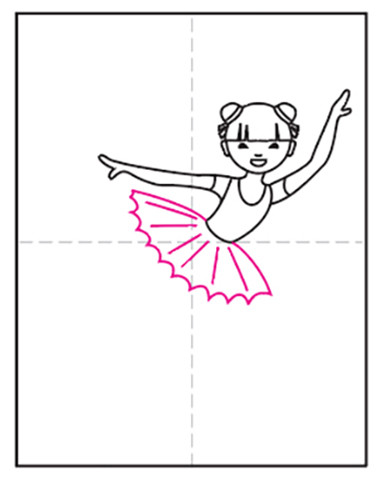 Adding details and shading to the ballerina dancer, creating shadows and highlights on the body and costume to enhance realism
Adding details and shading to the ballerina dancer, creating shadows and highlights on the body and costume to enhance realism
5.8. Step 8: Finalize the Drawing
Finalize the drawing by refining the lines, adding finishing touches, and erasing any unnecessary guidelines.
- Outline: Go over the main lines to make them bolder and more defined.
- Erasure: Erase any remaining guidelines or construction lines.
- Review: Review your drawing and make any final adjustments.
Your ballerina dancer drawing is now complete.
 Finalizing the drawing of the ballerina dancer, refining lines, adding finishing touches, and erasing unnecessary guidelines
Finalizing the drawing of the ballerina dancer, refining lines, adding finishing touches, and erasing unnecessary guidelines
5.9. Step 9: Add Color (Optional)
If desired, add color to your drawing using colored pencils, markers, or paint.
- Skin Tones: Choose appropriate skin tones to color the ballerina’s skin.
- Costume Colors: Select colors that complement the costume and add visual interest.
- Background: Add a background to create a sense of context and atmosphere.
Experiment with different color combinations and techniques to achieve your desired effect.
 Adding color to the ballerina dancer using colored pencils, selecting skin tones, costume colors, and a background to enhance the drawing
Adding color to the ballerina dancer using colored pencils, selecting skin tones, costume colors, and a background to enhance the drawing
6. Tips and Tricks for Drawing Ballerina Dancers
Here are some tips and tricks to help you improve your ballerina dancer drawings.
- Study Anatomy: Understanding the anatomy of the human body will help you draw more accurate and realistic figures.
- Use References: Use reference photos of ballet dancers to guide your drawing and ensure correct proportions and poses.
- Practice Regularly: Consistent practice is key to improving your drawing skills. Set aside time each day or week to draw.
- Experiment with Poses: Try drawing ballerinas in different poses to challenge yourself and expand your artistic repertoire.
- Vary Line Weight: Use different line weights to create depth and emphasis in your drawing.
- Pay Attention to Light and Shadow: Observe how light falls on the body and use shading to create a sense of volume and dimension.
- Capture Movement: Focus on capturing the fluidity and grace of ballet movements in your drawings.
- Seek Feedback: Share your drawings with other artists and ask for constructive feedback.
- Join a Class or Workshop: Consider taking a drawing class or workshop to learn new techniques and receive expert guidance.
- Visit ten-dance.com: Explore our website for more tutorials, tips, and resources on drawing and dance.
By incorporating these tips and tricks into your practice, you can elevate your ballerina dancer drawings to the next level.
7. Common Mistakes to Avoid When Drawing a Ballerina Dancer
Even experienced artists make mistakes. Here are some common pitfalls to avoid when drawing a ballerina dancer.
- Disproportionate Body: Ensure that the body parts are in proportion to each other. Use guidelines to maintain accuracy.
- Stiff Poses: Avoid drawing stiff, unnatural poses. Study reference photos to capture the fluidity of ballet movements.
- Lack of Detail: Add details to the costume, hair, and facial features to bring your drawing to life.
- Inconsistent Shading: Use consistent shading techniques to create a sense of depth and dimension.
- Ignoring Anatomy: Neglecting the underlying anatomy can result in unrealistic figures. Study anatomy to improve accuracy.
- Rushing the Process: Take your time and focus on each step of the drawing process. Avoid rushing to the finish.
- Fear of Mistakes: Don’t be afraid to make mistakes. They are part of the learning process. Use an eraser to correct errors and keep practicing.
By being aware of these common mistakes, you can avoid them and improve the quality of your ballerina dancer drawings.
8. How to Capture the Grace and Movement of a Ballerina Dancer
Capturing the grace and movement of a ballerina dancer is essential for creating compelling drawings. Here are some techniques to help you achieve this.
- Study Ballet Poses: Familiarize yourself with common ballet poses, such as arabesque, plié, and relevé.
- Use Dynamic Lines: Use flowing, dynamic lines to convey the fluidity of movement.
- Exaggerate Gestures: Exaggerate the gestures and poses to emphasize the movement and energy of the dance.
- Capture the Flow of Fabric: Pay attention to how the fabric of the tutu and costume flows and moves with the dancer’s body.
- Use Foreshortening: Use foreshortening to create a sense of depth and perspective in your drawing.
- Focus on Balance: Emphasize the balance and poise of the ballerina in your drawing.
- Convey Emotion: Capture the emotion and expression of the dancer in their facial features and body language.
- Use a Variety of Techniques: Experiment with different drawing techniques, such as gesture drawing, contour drawing, and shading, to capture the essence of the dance.
By mastering these techniques, you can create drawings that truly capture the grace and movement of a ballerina dancer.
9. Incorporating Different Ballet Styles into Your Drawings
Ballet encompasses various styles, each with its unique characteristics. Incorporating these styles into your drawings can add depth and variety to your artwork.
- Classical Ballet: Characterized by precise technique, elegant lines, and traditional costumes.
- Romantic Ballet: Emphasizes emotion, lyricism, and ethereal qualities, often featuring long, flowing tutus.
- Contemporary Ballet: Blends classical technique with modern dance elements, allowing for greater freedom of expression.
- Neoclassical Ballet: A fusion of classical and contemporary styles, often featuring minimalist costumes and abstract movements.
By studying and incorporating these different ballet styles into your drawings, you can create a diverse and captivating portfolio of ballerina art.
10. Advanced Techniques for Drawing Ballerina Dancers
For artists looking to take their ballerina drawings to the next level, here are some advanced techniques to explore.
- Anatomical Accuracy: Study human anatomy in detail to create highly realistic and accurate figures.
- Dynamic Posing: Experiment with complex and dynamic poses to capture the energy and movement of the dance.
- Detailed Costumes: Add intricate details to the costumes, such as lace, embroidery, and embellishments, to enhance the visual appeal.
- Advanced Shading: Use advanced shading techniques, such as cross-hatching and stippling, to create depth and texture.
- Mixed Media: Combine different drawing media, such as graphite, charcoal, and ink, to create unique and expressive effects.
- Backgrounds and Environments: Create detailed backgrounds and environments to provide context and atmosphere for your ballerina drawings.
- Storytelling: Use your drawings to tell stories and convey emotions, capturing the drama and beauty of ballet.
Mastering these advanced techniques will allow you to create truly exceptional ballerina dancer drawings that showcase your artistic skill and vision.
11. How to Find Inspiration for Your Ballerina Dancer Drawings
Finding inspiration is crucial for creating fresh and compelling artwork. Here are some sources of inspiration for your ballerina dancer drawings.
- Live Performances: Attend ballet performances to observe the dancers’ movements, costumes, and emotions firsthand.
- Ballet Photography: Study ballet photography to capture the beauty and artistry of dance in still images.
- Art Books: Explore art books featuring ballerina paintings and drawings by master artists.
- Online Galleries: Browse online art galleries and websites to discover contemporary ballerina art.
- Social Media: Follow ballet dancers, photographers, and artists on social media for daily inspiration.
- Museums and Exhibitions: Visit museums and art exhibitions showcasing ballet-themed artwork.
- Dance Classes: Take a ballet class to experience the movements and poses from a dancer’s perspective.
- ten-dance.com: Explore our website for inspiring articles, tutorials, and galleries featuring ballerina dancer art.
By tapping into these sources of inspiration, you can fuel your creativity and create unique and compelling ballerina dancer drawings.
12. Drawing Ballerina Dancers: A Therapeutic and Creative Outlet
Drawing ballerina dancers isn’t just about creating art; it’s also a therapeutic and creative outlet that offers numerous benefits.
- Stress Relief: The act of drawing can be a calming and relaxing activity that helps reduce stress and anxiety.
- Mindfulness: Drawing requires focus and concentration, promoting mindfulness and presence.
- Emotional Expression: Drawing provides a means of expressing emotions and feelings in a visual form.
- Creative Exploration: Drawing allows you to explore your creativity and experiment with different styles and techniques.
- Self-Esteem: Creating a beautiful drawing can boost your self-esteem and confidence.
- Personal Growth: Drawing challenges you to improve your skills and grow as an artist.
- Community Connection: Sharing your drawings with others can foster a sense of community and connection.
Whether you’re a professional artist or a beginner, drawing ballerina dancers can be a fulfilling and therapeutic activity that enriches your life.
13. Showcasing Your Ballerina Dancer Drawings
Once you’ve created your ballerina dancer drawings, it’s time to share them with the world. Here are some ways to showcase your artwork.
- Online Portfolio: Create an online portfolio to display your drawings and reach a global audience.
- Social Media: Share your drawings on social media platforms like Instagram, Facebook, and Pinterest.
- Art Competitions: Enter your drawings in art competitions to gain recognition and exposure.
- Art Exhibitions: Participate in art exhibitions and galleries to showcase your work in a physical space.
- Local Art Shows: Display your drawings at local art shows and community events.
- Online Marketplaces: Sell your drawings on online marketplaces like Etsy and Saatchi Art.
- Print-on-Demand Services: Use print-on-demand services to create and sell prints, posters, and merchandise featuring your drawings.
- ten-dance.com: Submit your drawings to our website for a chance to be featured in our online gallery.
By showcasing your ballerina dancer drawings, you can share your talent with the world, connect with other artists, and build a successful art career.
14. Resources for Further Learning
To continue your journey of learning how to draw ballerina dancers, here are some valuable resources to explore.
- Books:
- “Drawing the Head and Hands” by Andrew Loomis
- “Figure Drawing: For All It’s Worth” by Andrew Loomis
- “Anatomy for Sculptors” by Uldis Zarins and Sandis Kondrats
- Websites:
- ten-dance.com: Explore our tutorials, articles, and galleries on drawing and dance.
- Proko: A website offering figure drawing courses and resources.
- Ctrl+Paint: A website providing free digital painting tutorials.
- Online Courses:
- Skillshare: Offers a variety of drawing courses taught by professional artists.
- Udemy: Provides drawing courses for all skill levels.
- Coursera: Features art and design courses from top universities.
- YouTube Channels:
- Proko: Features figure drawing tutorials and anatomy lessons.
- Sycra: Offers drawing tutorials and art tips.
- Draw Mix Paint: Provides painting and color theory tutorials.
- Museums and Galleries:
- The Metropolitan Museum of Art (New York)
- The Louvre Museum (Paris)
- The National Gallery (London)
- Dance Organizations:
- American Ballet Theatre (New York): Address: 60 Lincoln Center Plaza, New York, NY 10023, United States. Phone: +1 (212) 769-7000. Website: ten-dance.com.
- The Royal Ballet (London)
- Paris Opera Ballet
By utilizing these resources, you can expand your knowledge, improve your skills, and continue to grow as an artist.
15. Staying Inspired and Motivated
Staying inspired and motivated is crucial for maintaining a consistent drawing practice. Here are some tips to help you stay on track.
- Set Realistic Goals: Set achievable goals for your drawing practice, such as completing a certain number of drawings each week or month.
- Create a Dedicated Workspace: Set up a dedicated workspace where you can focus and be creative.
- Join a Drawing Group: Join a drawing group or online community to connect with other artists and share your work.
- Take Breaks: Take regular breaks to avoid burnout and refresh your mind.
- Experiment with New Techniques: Try new drawing techniques and styles to keep your practice fresh and exciting.
- Challenge Yourself: Challenge yourself to draw subjects that are outside your comfort zone.
- Celebrate Your Progress: Celebrate your progress and reward yourself for achieving your goals.
- Stay Positive: Maintain a positive attitude and focus on the enjoyment of drawing.
By following these tips, you can stay inspired, motivated, and passionate about drawing ballerina dancers for years to come.
16. Exploring Digital Drawing Techniques
In addition to traditional drawing methods, exploring digital drawing techniques can open up new possibilities for your ballerina dancer art.
- Drawing Tablets: Use a drawing tablet with a stylus to create digital drawings on your computer.
- Drawing Software: Explore drawing software such as Adobe Photoshop, Corel Painter, and Procreate.
- Digital Brushes: Experiment with different digital brushes to create various effects and textures.
- Layers: Use layers to create complex and detailed drawings with greater flexibility.
- Coloring: Utilize digital coloring tools to add vibrant colors and gradients to your drawings.
- Animation: Create animated ballerina dancer drawings using animation software.
- Sharing: Share your digital drawings online and connect with other digital artists.
By embracing digital drawing techniques, you can expand your artistic toolkit and create stunning ballerina dancer art in the digital realm.
17. The Connection Between Dance and Drawing
There’s a strong connection between dance and drawing, as both art forms share common elements such as movement, composition, and expression.
- Understanding Movement: Drawing dancers helps you understand and appreciate the nuances of human movement.
- Composition and Form: Both dance and drawing involve arranging elements in a visually pleasing and harmonious way.
- Emotional Expression: Both art forms provide a means of expressing emotions and feelings through physical and visual language.
- Creativity and Imagination: Both dance and drawing require creativity and imagination to bring ideas to life.
- Discipline and Practice: Both art forms require discipline, practice, and dedication to master.
By exploring the connection between dance and drawing, you can gain a deeper understanding and appreciation of both art forms, enriching your artistic journey.
18. Addressing Challenges and Overcoming Obstacles
Learning to draw ballerina dancers can present challenges and obstacles along the way. Here’s how to address them and keep moving forward.
- Perfectionism: Avoid striving for perfection and focus on the process of learning and improving.
- Frustration: Take breaks when you feel frustrated and come back to your drawing with a fresh perspective.
- Self-Doubt: Believe in your abilities and focus on your progress rather than your shortcomings.
- Time Constraints: Set aside small blocks of time each day or week to draw, even if it’s just for 15-20 minutes.
- Lack of Motivation: Find sources of inspiration and connect with other artists to stay motivated.
- Criticism: Learn to accept constructive criticism and use it to improve your skills.
- Fear of Failure: Don’t be afraid to make mistakes and view them as opportunities for learning and growth.
By addressing these challenges and overcoming obstacles, you can continue to grow as an artist and achieve your drawing goals.
19. The Importance of Practice and Patience
Practice and patience are essential for mastering any skill, including drawing ballerina dancers.
- Consistent Practice: Set aside time each day or week to draw, even if it’s just for a short period.
- Repetition: Repeat exercises and techniques to reinforce your skills and build muscle memory.
- Experimentation: Try different approaches and techniques to find what works best for you.
- Patience: Be patient with yourself and don’t expect to see results overnight.
- Persistence: Keep practicing even when you feel discouraged or frustrated.
- Enjoy the Process: Focus on the enjoyment of drawing and let go of the pressure to be perfect.
With consistent practice and patience, you can gradually improve your drawing skills and create beautiful ballerina dancer art that you’re proud of.
20. Join the ten-dance.com Community
We invite you to join the ten-dance.com community, where you can connect with other dance and art enthusiasts, share your drawings, and learn from experienced artists.
- Share Your Artwork: Showcase your ballerina dancer drawings in our online gallery and receive feedback from other members.
- Connect with Artists: Connect with other artists and dancers from around the world and collaborate on projects.
- Participate in Discussions: Participate in discussions on drawing techniques, ballet styles, and art inspiration.
- Access Exclusive Content: Access exclusive tutorials, articles, and resources created by our team of expert artists.
- Stay Updated: Stay updated on the latest news, events, and trends in the world of dance and art.
Visit ten-dance.com today to join our vibrant community and take your ballerina dancer drawing journey to the next level.
Ready to bring your ballerina dancer drawings to life? Explore ten-dance.com for inspiring lessons, resources, and a community of fellow art and dance enthusiasts. Whether you’re seeking step-by-step tutorials or looking to connect with like-minded creatives, ten-dance.com has everything you need to unleash your artistic potential. Join us today and start creating your own graceful masterpieces. Address: 60 Lincoln Center Plaza, New York, NY 10023, United States. Phone: +1 (212) 769-7000. Website: ten-dance.com.
Frequently Asked Questions (FAQs)
1. What are the key elements to focus on when drawing a ballerina dancer?
Focus on capturing the dancer’s posture, the flow of their movements, and the details of their attire to reflect the elegance of ballet.
2. How can I improve the realism of my ballerina dancer drawings?
To improve realism, study anatomy, use reference photos, and focus on accurate proportions and shading techniques.
3. What are some common mistakes to avoid when drawing ballerinas?
Avoid disproportionate body parts, stiff poses, and a lack of attention to detail in the costume and facial expressions.
4. Where can I find inspiration for drawing ballerina dancers?
Attend live ballet performances, explore ballet photography, and browse online art galleries for inspiration.
5. What drawing materials are best for creating ballerina dancer art?
Use a combination of HB, 2B, and 4B pencils, a sketchbook, kneaded and pencil erasers, and blending tools for detailed drawings.
6. How can I convey the movement and energy of a ballerina dancer in my drawings?
Use dynamic lines, exaggerate gestures, and capture the flow of fabric to convey the dancer’s movement and energy.
7. What are some advanced techniques for drawing ballerina dancers?
Explore anatomical accuracy, dynamic posing, detailed costumes, and advanced shading techniques to enhance your drawings.
8. How can I incorporate different ballet styles into my drawings?
Study the characteristics of classical, romantic, contemporary, and neoclassical ballet to incorporate them into your art.
9. What are the benefits of drawing ballerina dancers as a creative outlet?
Drawing can provide stress relief, promote mindfulness, and allow for emotional expression, enhancing your overall well-being.
10. How can I showcase my ballerina dancer drawings to a wider audience?
Create an online portfolio, share your art on social media, enter art competitions, and participate in local art shows to showcase your work.
